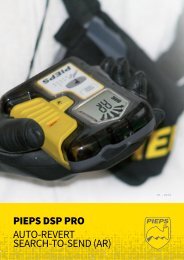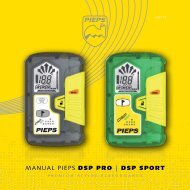LVS HintergrundwiSSen - pieps
LVS HintergrundwiSSen - pieps
LVS HintergrundwiSSen - pieps
Erfolgreiche ePaper selbst erstellen
Machen Sie aus Ihren PDF Publikationen ein blätterbares Flipbook mit unserer einzigartigen Google optimierten e-Paper Software.
Using a smaller search strip width would mean to spend much more time (running a longer way). Also the<br />
rescuer must have a look on it, not to increase this max. search strip width. In this case the possibility is very<br />
high, not to detect the transmitter and miss the victim (loosing time), while moving over the avalanche. The<br />
available beacons now, have an elliptic up to a circular receiving range (assists you most), because of the numbers<br />
and sizes of the different antennas and the technical performance inside the beacon.<br />
Picture 2:<br />
Typical receiving characteristic<br />
of a 1-antenna beacon<br />
Picture 3:<br />
Different characteristics<br />
of beacons with more<br />
than one antenna.<br />
A direction indication is<br />
given to the rescuer.<br />
To cover the recommended search strip width of a manufacturer, the rescuer has to know exactly how it has<br />
been defined and how his beacon is working.<br />
An example: The receiving beacon has an elliptic receiving range. A) The direction indication starts as soon as<br />
a receiving signal is detected on antenna -x and –y. B) Before getting a signal on the second antenna the beacon<br />
works like a 1-antenna beacon (bigger range) If the recommended search strip width depends on A), the<br />
rescuer has to use a special kind of work (turning around), not to miss the victim. If it is A), the rescuer has to<br />
run a longer distance, but must not think about the kind of work in this situation of stress.<br />
So at the time the advertised maximum search strip width by the manufacturer, depends on the method the<br />
manufacturer uses and its practical philosophy: “Maximum search strip width is the range within a direction<br />
indication is shown on the display and the rescuer must not think about how to handle his beacon to cover the<br />
given maximum search strip width” - or “The maximum search strip width is the max range the rescuer reaches<br />
if he combines the technical performance (max possible range) of his beacon with an optimal kind of work.”<br />
There are significant differences in recommendations of the search strip width in the international literature.<br />
Most beacons have a range of 60 to 80 meters, but some digital display beacons have a range of half that because<br />
the microprocessor filters the audio signal (Temper 2001). One person can search for signals by making<br />
traverses 20 m apart and 10 m from the edge of the deposit (Jamieson 2000). This is the reason why the search<br />
strip width is one of the most determining factors for your overall searching time.<br />
There are a vary of approaches, either based on measurement of the range in best coupling position and following<br />
mathematic reductions, or range tests using all different positions, while only the worst results are taken<br />
into account. Since there it seems to be no common understanding in the near future, we decided to describe,<br />
perform and analyze a new approach: Based on an avalanche field, divided like a chess field, beacons searches<br />
has been performed and tracked using a DGPS with an accuracy less than a couple of centimeters. Analysis,<br />
done afterwards, provides very interesting and highly relevant results.<br />
26<br />
PREMIUM ALPINE PERFORMANCE





